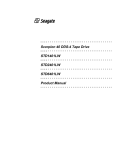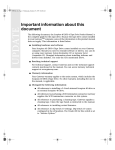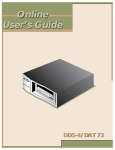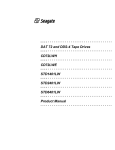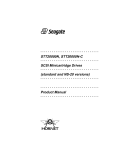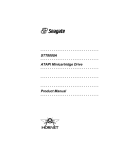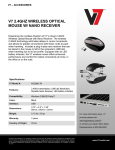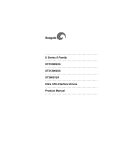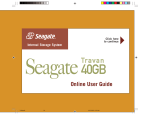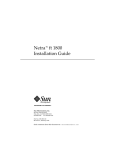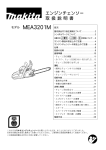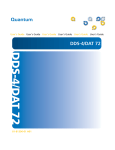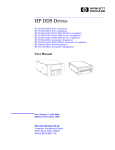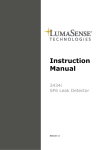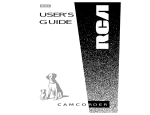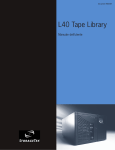Download Quantum DAT 240 Loader User's Manual
Transcript
...................................... Scorpion 240 DDS-4 Autoloader ...................................... STDL42401LW ...................................... STDL62401LW ...................................... ...................................... Product Manual ...................................... h ...................................... Scorpion 240 DDS-4 Autoloader ...................................... STDL42401LW ...................................... STDL62401LW ...................................... ...................................... Product Manual ...................................... © 2000 Seagate Removable Storage Solutions, LLC. All rights reserved Part Number 1001282230 Seagate and the Seagate logo are registered trademarks of Seagate Technology, LLC. Scorpion and the Scorpion logo are trademarks or registered trademarks of Seagate Removable Storage Solutions, LLC. Other product names are trademarks or registered trademarks of their owners. Seagate reserves the right to change, without notice, product offerings or specifications. No part of this publication may be reproduced in any form without written permission from Seagate Removable Storage Solutions, LLC. Publication Number T-006, October 2000 FCC Notice This equipment generates and uses radio frequency energy and, if not installed and used properly—that is, in strict accordance with the manufacturer’s instructions— may cause interference to radio communications or radio and television reception. It has been tested and found to comply with the limits for a Class B computing device in accordance with the specifications in Part 15 of FCC Rules, which are designed to provide reasonable protection against such interference in a residential installation. However, there is no guarantee that interference will not occur in a particular installation. If this equipment does cause interference to radio or television reception, which can be determined by turning the equipment on and off, you are encouraged to try to correct the interference by one or more of the following measures: • Reorient the receiving antenna. • Relocate the computer with respect to the receiver. • Move the computer into a different outlet so that the computer and receiver are on different branch circuits. If necessary, you should consult the dealer or an experienced radio/television technician for additional suggestions. You may find the booklet, How to Identify and Resolve Radio-TV Interference Problems, prepared by the Federal Communications Commission, helpful. This booklet (Stock No. 004-000-00345-4) is available from the U.S. Government Printing Office, Washington, DC 20402. Warning. Changes or modifications made to this equipment which have not been expressly approved by Seagate Technology may cause radio and television interference problems that could void the user’s authority to operate the equipment. Further, this equipment complies with the limits for a Class B digital apparatus in accordance with Canadian Radio Interference Regulations. Cet appareil numérique de la classe B est conforme au Règlement sur brouillage radioélectrique, C. R. C., ch. 1374. The external device drive described in this manual requires shielded interface cables to comply with FCC emission limits. Additional Warnings: • To prevent fire or electrical shock hazard, do not expose the unit to rain or moisture. • To avoid electrical shock, do not open the cabinet. • Refer servicing to qualified personnel. About This Manual All information contained in or disclosed by this document is considered proprietary by Seagate Technology. By accepting this material, the recipient agrees that this material and the information contained therein are held in confidence and in trust and will not be used, reproduced in whole or in part, nor its contents revealed to others, except to meet the purpose for which it was delivered. It is understood that no right is conveyed to reproduce or translate any item herein disclosed without express written permission from Seagate Technology. Seagate Technology provides this manual “as is,” without warranty of any kind, either expressed or implied, including, but not limited to, the implied warranties of merchantability and fitness for a particular purpose. Seagate Technology reserves the right to change, without notification, the specifications contained in this manual. Seagate Technology assumes no responsibility for the accuracy, completeness, sufficiency, or usefulness of this manual, nor for any problem that may arise from the use of the information in this manual. Following are brief descriptions of the sections in this manual. Chapter 1, “Introduction” provides general information, features and an overview on DDS technology. Chapter 2, “Specifications” contains physical, performance, environmental, reliability, and power specifications. Chapter 3, “Installation” provides cautions, unpacking tips, inspection information and installation/connection steps. Chapter 4, “Drive Operation and Maintenance” explains the operation of the drive and describes necessary maintenance procedures. Chapter 5, “Theory of Operations” details the functional operation of various components of the drive. Contents iii Contents Introduction 1 Overview ......................................................................................................................1 DDS Format Standard Compatibility .....................................................................1 Scorpion 240 Capacity and Transfer Rates ..........................................................2 Features.......................................................................................................................3 Scorpion 240 drive models ..........................................................................................4 Specifications 5 Overview ......................................................................................................................5 Physical Specifications ................................................................................................5 Power Specifications....................................................................................................6 Internal drive..........................................................................................................6 External drive ........................................................................................................7 Drive Performance Specifications................................................................................8 Environmental Requirements.......................................................................................9 Reliability......................................................................................................................9 Mean Time Between Failures..............................................................................10 Mean Time to Repair ...........................................................................................10 DDS Cartridge Specifications ....................................................................................10 Regulatory Compliance..............................................................................................11 Installation 13 Introduction ................................................................................................................13 Unpacking and Inspection..........................................................................................13 Installing an internal Scorpion 240.............................................................................13 Guidelines and cautions ......................................................................................14 Configuring an internal Scorpion 240 ..................................................................14 Jumper settings ...................................................................................................14 Dip-switch settings ..............................................................................................16 Mounting an internal Scorpion 240......................................................................18 Installing an external Scorpion 240............................................................................20 Configuring the external Scorpion 240 ................................................................20 Connecting the SCSI interface cable ..................................................................21 Connecting the power cord .................................................................................21 Scorpion 240 Product Manual iv Drive Operation and Maintenance 22 Starting the autoloader.............................................................................................. 22 Using cartridges and magazines............................................................................... 23 Applying labels.................................................................................................... 23 Loading cartridges in a magazine....................................................................... 23 Loading a magazine into the autoloader............................................................. 24 Ejecting a cartridge or magazine ........................................................................ 24 Automatic and manual cartridge loading ............................................................ 25 About the front-panel buttons.................................................................................... 26 Eject button......................................................................................................... 26 Select button....................................................................................................... 26 Enter button ........................................................................................................ 26 About the front-panel LEDs....................................................................................... 26 Clean LED .......................................................................................................... 27 Media LED .......................................................................................................... 27 Drive LED ........................................................................................................... 27 LED Code summary ........................................................................................... 28 About the front-panel LCD display ............................................................................ 28 LCD display backlighting .................................................................................... 29 LCD display messages....................................................................................... 29 Configuring autoloader features using the LCD display ..................................... 30 Cleaning the tape drive ............................................................................................. 31 Cleaning procedure ............................................................................................ 31 DDS-4 cartridge information...................................................................................... 32 DAT cartridge compatibility................................................................................. 32 Write-protecting the DAT cartridge and magazine ............................................. 33 Preparation for shipping ............................................................................................ 34 Theory of operations 35 Overview ................................................................................................................... 35 The DDS-4 drive mechanism ............................................................................. 36 Motors and control circuits ........................................................................................ 38 Timing tracking circuitry...................................................................................... 38 Signal-processing electronics............................................................................. 38 Flash memory ........................................................................................................... 39 Sensors ..................................................................................................................... 39 Read-After-Write ....................................................................................................... 39 Media Recognition System (MRS) ............................................................................ 40 Data compression ..................................................................................................... 40 About the DDS data cartridge ................................................................................... 41 v Contents Figures Figure 1. Internal Scorpion 240 drive, for full-height, 5.25-inch drive bay..........................................................4 Figure 2. External Scorpion 240 ........................................................................................................................4 Figure 3. Internal Scorpion 240 Drive—Dimensions..........................................................................................6 Figure 4. Jumper settings for internal Scorpion 240 ........................................................................................15 Figure 5 Dip-switch settings for internal Scorpion 240.....................................................................................16 Figure 6. Mounting holes and dimensions for the internal Scorpion 240 .........................................................18 Figure 7. Interface connector on internal Scorpion 240 ...................................................................................19 Figure 8. Two SCSI termination examples for internal Scorpion 240. .............................................................19 Figure 9. Rear panel of external Scorpion 240 ................................................................................................20 Figure 10. SCSI termination examples for external Scorpion 240 ...................................................................21 Figure 11. Front view of internal Scorpion 240 autoloader (external drive is similar) .......................................22 Figure 12. Inserting a cartridge into the autoloader magazine..........................................................................23 Figure 13. Loading a magazine into the autoloader..........................................................................................24 Figure 14. Autoloader Front Panel ....................................................................................................................26 Figure 15. LCD display features .......................................................................................................................28 Figure 16. Write-protect tab on the DAT cartridge ............................................................................................33 Figure 17. Write-protect switch on autoloader magazine..................................................................................33 Figure 18. Four-head cylinder design ..............................................................................................................37 Figure 19 Alternating azimuth angles on tape tracks.......................................................................................38 Figure 20. DDS cartridge design features........................................................................................................41 Figure 21. Write-Protect Tab on the DDS Cartridge ........................................................................................42 Introduction 1 1 Introduction Overview The Seagate® Scorpion® 240 digital data storage (DDS) autoloader is designed for computer environments that require high-performance, extra-high-capacity data storage. Based on a 3.5-inch mechanism, the internal and external Scorpion 240 autoloaders provide 20 Gbytes of data-storage capacity per cartridge (40 Gbytes compressed) for a total of 240 Gbytes (compressed) per six-cartridge magazine. The drive has a native transfer rate of 2.75 Mbytes per second, 5.5 Mbytes per second compressed. The Scorpion 240 drive combines established DAT technology, high-density recording and hardware data-compression capability, along with Seagate’s proven computer-grade design to provide unmatched reliability and performance characteristics among DDS products. The Scorpion 240 is ideal for server and network/enterprise applications such as: • Backup of high-capacity networks and disc arrays • Network and internet servers • Automated storage management • Online, unattended data collection • Near-line secondary storage for text, graphics or multimedia information • Archival storage DDS Format Standard Compatibility The Scorpion 240 drive supports the DDS-4, DDS-3, DDS-2 and DDS recording formats. Compatibility with each of these standards ensures complete write and read interchange of recorded digital data between all compliant drive and media vendors. Note: The Scorpion 240 can use 90-meter DDS-1 media but not 60-meter DDS-1 media. The Scorpion 240 drive supports DDS data compression, effectively doubling storage capacity and transfer rates. The Scorpion 240 drive complies with the following guidelines and specifications: • The DDS recording format standard, ANSI/ECMA-139, 3,81mm Wide Magnetic Tape Cartridge for Information Interchange - Helical Scan Recording - DDS Format. Scorpion 240 Product Manual 2 • The DDS-DC recording format standard, ANSI/ECMA-150, 3,81mm Wide Magnetic Tape Cartridge for Information Interchange - Helical Scan Recording DDS-DC Format using 90 m length tapes. • The DDS-2 recording format standard, ANSI/ECMA-198, 3,81mm Wide Magnetic Tape Cartridge for Information Interchange - Helical Scan Recording - DDS-2 Format using 120 m Length Tapes. • The DDS-3 recording format standard, ANSI/ECMA-236, 3,81mm Wide Magnetic Tape Cartridge for Information Interchange - Helical Scan Recording - DDS-3 Format using 125 m Length Tapes. • The DDS-4 recording format specification from ECMA-288: 3,81 mm Wide Magnetic Tape Cartridge for Information Interchange - Helical Scan Recording: DDS-4 Format. Note: For the latest ECMA standards, see the ECMA web site at http://www.ecma.ch Scorpion 240 Capacity and Transfer Rates The Scorpion 240 provides the following capacities and transfer rates, depending on recording mode and tape length: Recording Mode DDS DDS-2 DDS-3 DDS-4 Tape length 90 meters 120 meters 125 meters 150 meters Capacity (native) 2.0 Gbytes 4.0 Gbytes 12.0 Gbytes 20.0 Gbytes Capacity (compressed) 4 Gbytes 8 Gbytes 24 Gbytes 40 Gbytes Transfer rate (native) 915 Kbytes/sec 915 Kbytes/sec 2.75 Mbytes/sec 2.75 Mbytes/sec Note: 60-meter DDS tape cannot be used with the Scorpion 240. In data-compression mode, the Seagate Scorpion 240 drive typically doubles the storage capacity and transfer rate of the native uncompressed operation. Tape capacity and sustained data-transfer rate are dependent upon the characteristics of the files being compressed, along with system parameters such as the speed of the host, the operating system and the application software used. The Scorpion 240 drive also offers synchronous or asynchronous SCSI transfers with a high-speed burst data-transfer rate of 80 Mbytes per second. The Scorpion 240 provides superb reliability through three levels of error-correction code (ECC) and the four-head design, which provides for read-after-write (RAW) error detection and correction. The Scorpion 240 also includes a “flying” preamplifier for greater signal-to-noise ratio. Introduction 3 Features The Scorpion 240 DDS drive represents Seagate’s commitment to engineering reliable and durable tape drive products that implement leading-edge technology. Key features of the drive include: • Platform based on state-of-the-art drive mechanism and tape handling components sealed in a dust-free enclosure. • Two models available: 5.25-inch full-height internal drive (STDL42401LW) and external subsystem with built-in auto-sensing, worldwide power supply (model (STDL62401LW)) • ANSI/ECMA compliance and capability to write and read DDS-4, DDS-3, DDS-2, and DDS cartridges. (The Scorpion 240 can use 90-meter DDS-1 media but not 60-meter DDS-1 media). • Advanced onboard DDS-DC hardware using Data Compression Lempel-Ziv (DCLZ) data-compression algorithm • High-speed transfer rates for fast backups: – 2.75 Mbytes per second typical—uncompressed data – 5.5 Kbytes per second typical—compressed data • High-performance SCSI burst transfer rate of 10 Mbytes per second asynchronous and 80 Mbytes per second synchronous • Flash memory to store setup parameters and enable field firmware upgrades • Four-head design with RAW error detection and rewrites • Three levels of ECC to ensure data integrity • Uncorrectable error rate of less than 1 in 1015 bits • Custom Seagate-designed LSI circuitry to reduce component count and boost drive reliability • LVD / Ultra Wide SCSI connection • Automatic power-on self-test • Support for TapeAlert™ Certified Solutions Scorpion 240 Product Manual 4 Scorpion 240 drive models The Scorpion 240 is available as a 5.25-inch, full-height internal drive (Figure 1) or as an external, standalone drive unit with built-in power supply (Figure 2). Figure 1. Internal Scorpion 240 drive, for full-height, 5.25-inch drive bay Figure 2. External Scorpion 240 Specifications 5 2 Specifications Overview This chapter includes technical specifications for the internal and external SCSI drives. This information covers the following specifications and requirements: • Physical specifications • Power specifications • Drive performance specifications • Environmental requirements • Reliability • DDS cartridge specifications • Regulatory compliance Physical Specifications The physical specifications of the Scorpion 240 internal and external drives are listed in the following table: Specification Internal drive External drive Height 3.25 in (82.5 mm) 4.80 in (121.9 mm) Width 5.75 in (146 mm) 9.75 in (248 mm) Length 8.80 in (223.5 mm) 13.38 in (340 mm) Weight 4.5 lb (2.05 kg) 8.1 lb (3.67 kg) Note. The internal drive dimensions do not include the front bezel, which is approximately 3.38 X 5.89 X 0.27 inches Figure 3 on the following page shows the mounting dimensions of the internal drive. 79.5 ± 0.25 MOUNT HOLE M3 (4 PLACES) 203.2 ± 0.25 7.0 ± 0.3 82.6 ± 0.6 11.9 ± 0.3 1.8 ± 0.25 86 ± 0.25 45.5 ± 0.25 21.8 ± 0.3 Scorpion 240 Product Manual 6 45.5 ± 0.25 79.5 ± 0.25 146 +1.5 –0.5 139.7 ± 0.3 149.6 ± 0.25 1.8 ± 0.25 224.0 max MOUNTING HOLE M3 (4 PLACES) 203.2 ± 0.5 224.0 max Figure 3. Internal Scorpion 240 Drive—Dimensions Power Specifications Internal drive The following table lists the power specifications for the internal Scorpion 240 drives. Specification +12 VDC supply +5 VDC supply Voltage Tolerance Operational Current Standby Current Surge (peak) Ripple (peak-to-peak) + or – 10% 700 milliamps max 500 milliamps max 2400 milliamps max ≤ 100 mV + or – 7% 1.70 Amps max 1.0 Amps max 2.0 Amps max ≤ 100 mV Specifications 7 Total power consumption for the Scorpion 240 (including both the +5V and +12V power supplies) is as follows: Standby Power 11 Watts max Operating Power 17 Watts typical, 28 Watts max Surge (start up) 39 Watts max Note: Surge power and current are measured over a 20-msec period. The following table lists pin assignments of the power connector for the internal Scorpion 240. Pin Assignment 1 +12 VDC 2 +12 return 3 +5 return 4 +5 VDC Note: The internal Scorpion 240 employs a power sensing circuit that automatically detects a loss of supply voltage from the host. Temporary loss of supply voltage or voltage spikes may result in the drive electronics being reset to their initialized state, but shall under no circumstances result in a loss of recorded data. External drive The external Scorpion 240 has a built-in power supply that senses the incoming voltage and automatically adapts to voltages within the range of 100 to 240 volts, 50 to 60 Hz. The following table lists its power specifications. Specification AC Input Current AC Input Power 100 (Japan) 100 milliamps 10.0 watts AC Input Voltage 120 (US) 240 (European) 85 milliamps 170 milliamps 10.0 watts 10.0 watts Scorpion 240 Product Manual 8 Drive Performance Specifications The following table lists the specifications for the Scorpion 240 autoloader and tape drive. Specification Value Capacity (six-cartridge magazine; 2:1 data compression) 90 m MP 120 m MP+ 125 m MP++ 150 m MP+++ Flux density (DDS-4) 24.0 Gbytes 48.0 Gbytes 144.0 Gbytes 240.0 Gbytes 6,004 flux transitions per mm Track density (DDS-4) 147.34 tracks per mm Error recovery Recording unrecoverable errors Read-after-write Reed Solomon ECC (C3 - 3 levels) < 1 in 10 15 data bits Tape drive type Computer grade 4DD mechanism Head configuration 2 read heads, 2 write heads Recording format DDS-4 Recording method Helical scan (R-DAT) Cartridge 2.9 in × 2.1 in × 0.4 in Transfer rate (sustained) 5.500 Kbytes per sec (DC ON) Synchronous transfer rate (burst) 80 Mbytes per sec max Asynchronous transfer rate (burst) 10 Mbytes per sec max Search speed (max) 400x normal (3260 mm per sec) Average access time 90 m cartridge 120 m cartridge 125 m cartridge Drum rotation speed <30 sec <40 sec <40 sec 10,000 RPM (all DDS modes) Tape speed 20.375 mm per sec. Head-to-tape speed 20.4 mm per sec. Specifications 9 Environmental Requirements The following table lists the environmental specifications for Scorpion 240. Specification Operational Nonoperational Temperature +41o –40o to +149oF2 (–40o to + 65oC) Below condensation Thermal gradient Relative humidity Maximum wet bulb temperature Altitude +113oF1 to (+5o to + 45oC) 2oC per min / 8oC per hr (no condensation) 20% to 80% noncondensing1 78.8oF (26oC) –100 to +4,575 meters Vibration Sweep test Dwell test (15 minutes) Acoustic level idling (A-wt sum) Acoustic level operational (A-wt sum) Shock (1/2 sine wave) 0% to 90% noncondensing2 No condensation –300 to +15,200 meters (power off) 1.5 G (5 to 500 Hz) 1.20 mm peak-to-peak (5–17 Hz) 0.73 G peak (17 to 150 Hz) 0.50 G peak (150–500 Hz) (sweep rate 8 decades per hour) 0.90 mm peak-to-peak (5–17 Hz) 0.55 G peak (17 to 150 Hz) 0.25 G peak (150–500 Hz) 47 dBA maximum NA 60 dBA maximum NA 10 Gs peak, 11 msec 50 Gs peak, 11 msec 1. Mechanism and media 2. Mechanism Reliability The Scorpion 240 drive is designed for maximum reliability and data integrity. The following table summarizes the reliability specifications. Specification Value Nonrecoverable error rate < 1 in 10 bits Error recovery and control Error-correction code techniques (C1, C2, & C3 ECC) Read-after-write (RAW) N-Group writing (DDS-1 and DDS-2 modes only) Error monitoring and reporting (error log) Retry on read Data randomizer Track checksum 100,000 power-on hours at 30% duty cycle 15 Mean time between failures (MTBF) Cassette Load/Unload Power On/Off Magazine Load/Unload Mean time to repair (MTTR) 150,000 cycles (assuming 60-second swap times) 10,000 cycles 25,000 cycles Less than 0.5 hour Scorpion 240 Product Manual 10 Mean Time Between Failures The mean time between failures (MTBF) is specified at 100,000 power-on hours minimum. This specification includes all power-on and operational time but excludes maintenance periods. Operational time is assumed to be 30 percent of the power-on time. Operational time is the time the tape is loaded on the cylinder (tape moving and/or cylinder rotating). Note. The MTBF rating does not represent any particular drive, but is derived from a large database of test samples. Actual rates may vary from unit to unit. Mean Time to Repair The mean time to repair (MTTR) is the average time required by a qualified service technician to diagnose a defective drive and to install a replacement drive. The MTTR for DAT products is less than 0.5 hour (30 minutes). The Seagate DDS drives are field-replaceable units. If a problem occurs with a subassembly or component in the drive, you should replace the entire unit. Return the drive to the factory in its original packaging. Contact your distributor, dealer, your computer system company or your Seagate sales representative to arrange the return. DDS Cartridge Specifications DDS drives provide maximum data integrity and reliability when Seagate-qualified DDS cartridges are used as the recording media. Seagate maintains an ongoing program to qualify manufacturers of DDS cartridges. The following cartridges are recommended: • DDS-2 data cartridge: model M34000, 120-meter tape • DDS-3 data cartridge: model STDM24G, 125-meter tape • DDS-4 data cartridge: model STMD40, 150-meter tape • DDS-4 cleaning cartridge: model 90301 Note. Use only a Seagate-qualified DDS-4 cleaning cartridge with the Scorpion 240 to avoid damaging the drive. Contact your Seagate sales representative for information on qualified DDS data and cleaning cartridge manufacturers and models. Specifications 11 Regulatory Compliance These DDS drives comply with the regulations listed in the following table. Agency Regulation CSA C22.2, No. 950-M89 TUV-RHEINLAND EN 60 950 UL 1950 FCC Class A and Class B1 CE CE compliance 1. Required compliance for external model; verification on file for internal models. Use these drives only in equipment where the combination has been determined to be suitable by an appropriate certification organization (for example, Underwriters Laboratories Inc. or the Canadian Standards Association in North America). You should also consider the following safety points: • Install the drive in an enclosure that limits the user’s access to live parts, gives adequate system stability and provides the necessary grounding for the drive. • Provide the correct voltages (+5 VDC and +12 VDC) based on the regulation applied—Extra Low Voltage (SEC) for UL and CSA and Safety Extra Low Voltage for BSI and VDE (if applicable). Installation 13 3 Installation Introduction This chapter explains how to install the Scorpion 240 internal and external drives. The contents are organized as follows • Unpacking and Inspection: contains general information that you should read before installation. • Installing the Internal Drives: describes how to install the internal drive in a fullheight drive bay. • Installing the External Drive: describes how to install the external subsystem. Unpacking and Inspection Although drives are inspected and carefully packaged at the factory, damage may occur during shipping. Follow these steps while unpacking the drive. • Visually inspect the shipping containers and notify your carrier immediately of any damage. • Place shipping containers on a flat, clean, stable surface; then carefully remove and verify the contents against the packing list. If any parts are missing or the equipment is damaged, notify your Seagate representative. • Always save the containers and packing materials for any future reshipment. Installing an internal Scorpion 240 Internal drive installation involves three main steps: 1. Configuring the drive 2. Mounting the drive 3. Connecting the power and interface cables Note: The Scorpion 240 is available with several different front bezel configurations. The illustrations here show one possible configuration. However, installation procedures are the same for all bezel configurations. Scorpion 240 Product Manual 14 Guidelines and cautions The following guidelines and cautions apply to handling and installing the Scorpion 240 internal drive. Keep them in mind as you install the drive. • Internal drives contain some exposed components that are sensitive to static electricity. To reduce the possibility of damage from static discharge, the drives are shipped in a protective antistatic bag. • Do not remove the drive from the antistatic bag until you are ready to install it. • Before you remove the drive from the antistatic bag, touch a metal or grounded surface to discharge any static electricity buildup from your body. • Hold the drive by its edges only, and avoid direct contact with any electronic components. • If you need to put down the drive, lay it on top of the antistatic bag or place it inside the bag. Configuring an internal Scorpion 240 Before you install the tape drive in your computer, you may need to configure the drive’s SCSI ID or other drive features using jumpers or dip switches. Default settings The default drive settings for the Scorpion 240 are listed below: Drive setting SCSI ID Media Recognition System (MRS) checking Parity checking SCSI terminator power Data compression Power-on self-test diagnostics Default condition 6 Enabled Enabled Disabled Enabled Enabled If these default settings are appropriate for your needs, skip ahead to “Installing an internal Scorpion 240” on page x. Jumper settings Configuration jumpers on the back of the drive are used to control the drive’s SCSI ID, parity checking, and SCSI terminator power. Figure 4 shows the locations of the jumper blocks for the internal Scorpion 240. Note: Power down the drive before changing jumpers or dip switches. Changes take effect when the drive restarts. Installation 15 Default jumper settings shown (SCSI ID 6, parity checking enabled, and termination power disabled) Pins: 1-2 3-4 5-6 7-8 9-10 11-12 Function: SCSI ID bit 0 SCSI ID bit 1 SCSI ID bit 2 SCSI ID bit 3 Parity checking Termination Power SCSI ID=0 SCSI ID=8 SCSI ID=1 SCSI ID=9 SCSI ID=2 SCSI ID=10 SCSI ID=3 SCSI ID=11 SCSI ID=4 SCSI ID=12 SCSI ID=5 SCSI ID=13 SCSI ID=6 SCSI ID=14 SCSI ID=7 SCSI ID=15 Parity enable Term. power Figure 4. Jumper settings for internal Scorpion 240 SCSI Address Selection (pins 1 through 8) Each SCSI device on a bus must have a unique SCSI ID. The SCSI controller or host adapter generally uses ID 7. In some systems, the boot drive uses ID 0 or ID 1. You can select the SCSI address used by the drive by placing the appropriate jumpers on pins pairs 1-2 through 7-8, as shown in Figure 4. Note: SCSI addresses 8 through 15 will only be recognized if dip switch 9 is set to “ON.” See page 17 for details. Scorpion 240 Product Manual 16 Parity checking (pins 9 and 10) If a jumper is installed on pins 9 and 10 (the default setting), parity checking is enabled. If no jumper is installed, parity checking is disabled, but parity is still generated by the drive. Terminator power (pins 11 and 12) Internal Scorpion 240 drives are shipped with terminator power disabled (no jumper across pins 11 and 12). You can enable terminator power, if necessary, by placing a jumper across pins 11 and 12. Note: The internal Scorpion 240 does not provide SCSI termination, and therefore should not be installed as the last device in a SCSI chain. See page 19 for details. Dip-switch settings To change data compression, MRS checking, power-on self-test diagnostics, operating system settings, Wide/Narrow SCSI selection, or the drive’s inquiry string, you must use the dip switches on the underside of the internal drive. Figure 5 shows the location of dip switches on the underside of the Scorpion 240. Each of these switches is described in detail on the following pages. Note: Power down the drive before changing jumpers or dip switches. Changes take effect when the drive is powered on. 1 2 3 4 5 6 7 8 9 10 O N Data compression (DC) SCSI DC control Media recognition Self Test Operating-system configuration switches Wide/Narrow SCSI Inquiry String support Default settings shown Figure 5 Dip-switch settings for internal Scorpion 240 Installation 17 Data compression (switches 1 and 2) If switch 1 is ON (the default setting), hardware data compression is enabled when the drive is powered on. If switch 1 is OFF, hardware data compression is disabled at power-on. If dip switch 2 is ON (the default setting) then SCSI commands can be used to enable or disable hardware data compression. To prevent hardware data compression from being enabled or disabled by SCSI commands, set dip switch 2 to OFF. Media-recognition system (switch 3) The media-recognition system allows the drive to determine whether a given tape cartridge conforms to the DDS tape standard. Use of non-DDS media may appear to give satisfactory results, but the inferior specifications of such media can cause dataintegrity problems. Switch 3 enables or disables the media-recognition system (MRS). If switch 3 is ON (the default setting), the drive reads and writes to MRS media and reads from but does not write to non-MRS media. If switch 3 is OFF, the drive reads or writes both MRS and non-MRS media. Power-on self-test enable/disable (switch 4) Switch 4 enables or disables execution of power-on self-test diagnostics when the drive is powered on. If switch 4 is ON (the default setting), the drive performs a power-on self-test. If switch 4 is OFF, the drive does not perform a power-on self test. Operating System configuration (switches 5 through 8) Switches 5 through 8 are used to configure the drive for use with certain nonWindows operating systems. The default setting for all four of these switches is ON. SCSI Wide/Narrow (switch 9) Switch 9 enables or disables SCSI Wide operation on the SCSI bus. When switch 9 is ON (the default setting), the drive is capable of operating in Wide (16-bit) SCSI mode. When switch 9 is OFF, the drive will only operate as a Narrow (8-bit) SCSI device. Note: If switch 9 if set to OFF, the drive can only use SCSI ID values 0 through 7. Inquiry string switch (switch 10) Switch 10 is used to select the Vendor ID that the drive returns when queried with a SCSI Inquiry command. When switch 10 is ON (the default setting), the Vendor ID will be “SEAGATE DAT.” When switch 10 is OFF the Vendor ID will be “ARCHIVE Python.” The “ARCHIVE Python” Vendor ID may be used by independent software vendors to provide software compatibility with previous Seagate DDS tape drives. Scorpion 240 Product Manual 18 Mounting an internal Scorpion 240 79.5 ± 0.25 203.2 ± 0.25 7.0 ± 0.3 82.6 ± 0.6 11.9 ± 0.3 45.5 ± 0.25 21.8 ± 0.3 1.8 ± 0.25 86 ± 0.25 The internal Scorpion 240 is designed to be mounted horizontally in a 5.25-inch, fullheight drive bay using four side- or bottom-mounting screws. Figure 6 below shows the locations of the mounting-screw holes and mounting dimensions for the internal drive. MOUNT HOLE M3 (4 PLACES) 45.5 ± 0.25 79.5 ± 0.25 146 +1.5 –0.5 139.7 ± 0.3 149.6 ± 0.25 1.8 ± 0.25 224.0 max MOUNTING HOLE M3 (4 PLACES) 203.2 ± 0.5 224.0 max Figure 6. Mounting holes and dimensions for the internal Scorpion 240 Connecting the SCSI interface cable Scorpion 240 drives can be used with two different types of SCSI interfaces: Ultra2 SCSI (LVD) or “Wide” (16-bit) single-ended SCSI. The drive can automatically detect whether it is connected to an LVD or single-ended wide SCSI bus. Note: The Scorpion 240 will not operate in a SCSI-1 environment. Installation 19 Connecting to a 68-pin Wide SCSI or LVD bus To connect the drive to an LVD or SCSI wide bus, first turn off all power to the drive and computer. Then attach the interface cable to the SCSI interface connector on the back of the drive (see Figure 7). pin 34 pin 68 Power connector pin 1 Ultra2 SCSI 68-pin high-density connector pin 4 +5V pin 35 pin 3: GND (+5V return) pin 1 +12V pin 2: GND (+12V return) Figure 7. Interface connector on internal Scorpion 240 SCSI Termination The internal Scorpion 240 does not provide SCSI termination. For this reason, it should not be the last device on a SCSI chain. Two termination examples are shown in Figure 8 below. If the drive is the only SCSI device, attach the drive to the connector which is next to last on the SCSI chain and attach a multi-mode terminator to the last connector in the chain. SCSI device SCSI Terminator (termination enabled) Internal Tape drive Internal Tape drive (no termination) (no termination) SCSI device SCSI device (termination disabled) (termination disabled) SCSI Controller (termination enabled) SCSI Controller (termination enabled) Figure 8. Two SCSI termination examples for internal Scorpion 240. Connecting a power cable Attach a four-pin power cable to the power connector on the back of the drive (see Figure 7 above). The recommended power connector for the internal Scorpion 240 is an AMP 1-48024-0 housing with AMP 60617-1 pins or equivalent. Scorpion 240 Product Manual 20 Installing an external Scorpion 240 The external Scorpion 240 is a compact external SCSI device that connects to the host computer as a turnkey subsystem. Installing the external drive involves three simple steps: 1. Configuring the drive 2. Connecting the SCSI interface cable 3. Connecting the power cord Configuring the external Scorpion 240 The following is the default configuration for the external Scorpion 240: Drive configuration SCSI ID Media Recognition System (MRS) checking Parity checking Data compression Power-on self-test diagnostics Host operating system Termination power Note: Default setting 6 Enabled. Enabled. Enabled. Enabled. Windows 95/98/NT/2000 Supplied to the SCSI bus. Some of these configuration settings can be changed using the SCSI Mode Select command. SCSI command information for these drives is provided in the Scorpion 240 SCSI manual. Setting the SCSI ID Make sure that the drive is turned off; then set the SCSI ID for the drive using the pushbutton switch on the back of the external drive. Figure 9 shows this switch, as well as the two SCSI interface connectors, on/off switch, and the power-cord connector. Note: The drive must be restarted for any change in SCSI ID to take effect. SCSI ID selector On/Off switch + – 68-pin wide SCSI connectors AC Power connector Figure 9. Rear panel of external Scorpion 240 Installation 21 Connecting the SCSI interface cable The Scorpion 240 provides two 68-pin, shielded connectors on the rear panel of the enclosure. Either connector can be used as a SCSI IN or SCSI OUT connection (you can use either connector to attach the drive to the host computer or to another SCSI device). Turn off your computer and all SCSI devices. Then attach a SCSI cable from the host adapter or from another (unterminated) SCSI device to the Scorpion 240. Note: The Scorpion 240 will not operate in a SCSI-1 environment. SCSI Termination If the Scorpion 240 is the last device or the only device in a SCSI chain, you must install a terminating plug on the unused SCSI connector. See Figure 10 for two SCSI termination examples. You can purchase a terminator for the Scorpion 240 (part number 10006525-001) on the web at http://buytape.seagate.com. External SCSI device SCSI Terminators External Tape Drive External Tape Drive External SCSI device SCSI Controller (termination disabled) SCSI Controller (termination enabled) Example 1: SCSI termination in a system that has only external SCSI devices. Internal SCSI device (termination enabled) Example 2: SCSI termination in a system that has both internal and external SCSI devices. Figure 10. SCSI termination examples for external Scorpion 240 Connecting the power cord Attach the power cord securely to the power connector on the back of the drive. The location of the power connector is shown in Figure 9 on the previous page. Scorpion 240 Product Manual 22 4 Drive Operation and Maintenance This section describes how to use your Scorpion 240 autoloader and DDS-4 cartridges. It also explains how to interpret the LEDs and the display on the front of the drive, which are shown in Figure 11. EJECT Button SELECT Button ENTER Button Clean LED (green) Media LED (green) Drive LED (amber) LCD Display Figure 11. Front view of internal Scorpion 240 autoloader (external drive is similar) Starting the autoloader Turn on all SCSI devices attached to your computer before you turn on the computer. When the autoloader is first started, the following events should occur: 1. The Clean, Media, and Drive LEDs light up for two seconds, then start flashing. 2. The LCD display shows the current SCSI ID, followed by the message, “WAITING SELFTEST.” 3. If a magazine is loaded, the drive determines which slots in the magazine contain cartridges . During this time the LCD display shows the message “SCAN X,” where X is the number of the cartridge slot currently being scanned (from 1 to 6). 4. As each cartridge is identified by the drive, the cartridge’s slot number is displayed on the LCD. 5. When all tests are completed, the LCD display shows the message “READY” if a magazine is loaded. If no magazine is loaded, the message “NO MAGAZINE” is shown. Drive Operation and Maintenance Note. 23 If your computer does not recognize the autoloader, you may need to load the appropriate autoloader module for your software package. See your software installation manual for additional information. Using cartridges and magazines Applying labels When applying labels to a cartridge, observe the following precautions to prevent the cartridge from getting stuck in the autoloader: • Apply labels firmly, only in recessed label areas. • Do not let labels extend beyond label areas or fold over the edge of a cartridge. • Do not apply labels over other labels. Caution Do not place any labels on the autoloader magazine, since this may cause the tape mechanism to jam. Loading cartridges in a magazine Use only approved DDS cartridges in the Scorpion 240. Approved Seagate cartridges are listed on page 10. To load cartridges into the magazine, follow these steps: 1. Make sure that the cartridges and magazine are write protected or write enabled, as necessary. See page 33 for details. 2. Hold the magazine so that the slot numbers on the side of the magazine are right-side-up. 3. Insert the cartridge into the magazine with the door facing toward the magazine slot, as shown in Figure 12. Cartridge door Figure 12. Inserting a cartridge into the autoloader magazine Scorpion 240 Product Manual 24 Loading a magazine into the autoloader Caution. Do not load a magazine if all the LEDs are flashing; this indicates that the drive is performing a power-on self test. 1. Make sure the drive is powered on and operating normally. 2. Hold the magazine so that the slot numbers are right-side-up. 3. Write protect or write-enable the magazine as appropriate. See page 33 for details. 4. Insert the magazine into the autoloader with the triangles facing into the autoloader bay, as shown in Figure 13. Gently push the magazine into the autoloader bay until the autoloader mechanism senses the magazine and pulls it inside. Figure 13. Loading a magazine into the autoloader Ejecting a cartridge or magazine To eject the magazine from the autoloader, press the Eject button. If a cartridge is in the drive, the LCD display shows the message “EJECT? PRESS ENTER”. Press the Enter button, and wait for the following events to complete: 1. The tape rewinds to the beginning-of-partition (BOP) mark. 2. If the tape cartridge is not write-protected (read-only), the operating system writes the updated copy of the tape log back to the tape. 3. The tape rewinds to the beginning-of-media (BOM) and is unthreaded. 4. The changer places the cartridge back into the magazine. 5. The magazine is ejected. If there is no cartridge in the tape drive, the magazine is ejected without delay. Drive Operation and Maintenance 25 Forcing an eject If you press the Eject button when the tape drive is busy, the tape drive first completes the current task before responding to the eject request. This way no data is lost. However, in extreme cases, you may need to force an eject to unload a cartridge, even at the risk of losing the data on the cartridge. A forced eject should only be tried when there is no other way to recover a cartridge. Caution. If you force an eject, the cartridge may become unreadable and may require erasing or re-initializing by the application software. You can also force an eject when you need to eject the magazine and there is no cartridge loaded in the drive. If you force an eject when a cartridge is not loaded, the autoloader waits 35 seconds, ejects the magazine, and then resets as though it had been turned off and then turned on. To force an eject, hold down the Eject button for at least five seconds, then release the button. When you force an eject, the following occurs: If there is a tape in the drive, the Status Panel displays the message “UNLOAD TAPE X” (where X is the number of the magazine slot which held the tape currently in the drive). After the tape has been returned to the magazine, the display changes to “EJECTING MAGAZINE” and the magazine is ejected. Note. Because forcing an eject can interrupt an operation, the tape drive might not write the end of data (EOD) mark on the tape before the cartridge is ejected. If the EOD mark is not written on the tape, the tape might be formatted incorrectly and the data on the tape might be lost. However, the data can usually be read up to the point where the error occurred, if a tape is correctly formatted. If forcing an eject does not successfully remove a cartridge or the magazine, contact Seagate technical support. Automatic and manual cartridge loading After cartridges have been loaded into the magazine and the magazine has been inserted into the magazine bay, the autoloader can be left indefinitely for unattended write or read operations. To load a tape manually, press the SELECT button to select the desired tape slot, then press the ENTER button. Scorpion 240 Product Manual 26 About the front-panel buttons This section describes the functions of the autoloader buttons. These buttons are shown in Figure 14. EJECT Button SELECT Button ENTER Button Clean LED (green) Media LED (green) Drive LED (amber) LCD Display Figure 14. Autoloader Front Panel Eject button You can use the Eject button to eject the magazine or to unload a cartridge from the drive. After pressing the Eject button, you must press the Enter button to confirm your request. Select button You can use the Select button to select individual tape cartridges by their slot numbers (1-6), to scroll through items from menus on the LCD display, and to access loader menus if no magazine is installed. Enter button You can use the Enter button to select specific items from menus on the LCD display, to load a cartridge into the drive (after you have selected the cartridge using the Select button), or to confirm that you want to eject the magazine when there is a tape in the drive. About the front-panel LEDs As shown in Figure 14, the front panel of the Scorpion 240 Autoloader includes three LEDs that provide information during normal and error conditions. This section summarizes the LED flash codes used by the Scorpion 240. Drive Operation and Maintenance 27 Clean LED The Clean LED functions as follows: • If the Clean LED is ON continuously, the drive requires cleaning. Use only a Seagate-approved cleaning cartridge to clean the drive, as described on page 31. • If the Clean LED is flashing slowly, the tape cartridge currently in use has exceeded a predefined soft-error threshold. This signal is a warning only and does not indicate that data has been lost. If you see this signal, remove the tape at your earliest convenience and clean the drive using a Seagate-approved DDS cleaning cartridge. If, after cleaning the drive and reinserting the original data cartridge, the Clean LED still flashes, then you should use a new cartridge for future backups. Media LED The Media LED functions as follows: • If the Media LED is ON (lit) continuously, a DDS cartridge has been inserted and the drive is operating normally. • If the Media LED is flashing rapidly, the drive could not write the tape correctly (maximum rewrite count exceeded) and the write operation failed. Clean the drive heads using a Seagate-approved DDS cleaning cartridge. If you reinsert the original data cartridge and the LED continues flashing, insert a new data cartridge and retry the operation. Note: As routine maintenance, you should clean the drive heads after every 25 hours of operation when using DDS-1 or DDS-2 tapes or after every 50 hours when using DDS-3 or DDS-4 tapes. Drive LED The Drive LED functions as follows: • If the Drive LED is ON continuously, the drive is reading or writing the tape (that is, SCSI or tape activity is present). Caution. Note: • If you push the Eject button while the Drive LED is ON, you will interrupt any host operation, causing an application error. It may not be possible to append to the tape if a write operation is aborted in this way. If a SCSI Prevent Media Removal command has been issued, the Drive LED remains ON and the eject button is disabled so that the tape cannot be accidentally ejected. If the Drive LED is flashing rapidly, a hardware fault has occurred. If this occurs immediately after powering on the drive, then the Power-On Self Test switch is enabled and a Power-On Self Test has failed. The front panel LEDs may be flashing together. If this occurs contact the Seagate Technical Support department for information. If the Drive LED is flashing rapidly during drive operation, you should attempt to remove the tape by pressing the Eject button. If the tape does not eject within 2 minutes, press and hold the Eject button Scorpion 240 Product Manual 28 continuously for more than 5 seconds. The tape should eject within 40 seconds. Contact Seagate Technical Support for more information. LED Code summary The following table summarizes LED flash codes for the Scorpion 240. LED Action Meaning Clean ON (lit) Cleaning is required because the drive has been operated for at least 25 hours (DDS-1 and DDS2) or 50 hours (DDS-3 or DDS-4). Flashing Slowly The internal error rate threshold has been exceeded and cleaning is required. Flashing The cleaning cartridge in the drive has exceeded its useful life. Replace the old cleaning cartridge with a new one. ON (lit) A cartridge is inserted and is not generating excessive errors. Flashing The drive could not write the tape correctly (a write error has occurred). Use a Seagateapproved cleaning cartridge to clean the drive. ON (lit) The drive is reading or writing the tape normally. Flashing Rapidly A hardware fault occurred. Media Drive About the front-panel LCD display Figure 15 shows the types of information shown on the front-panel LCD display. Indicates slot number of active cartridge Indicates whether active catridge or magazine is write-protected WP 1 2 3 LINE 1 LINE 2 Bar graph indicating current position of tape head relative to beginning of partition. Figure 15. LCD display features 4 5 6 Indicates whether datacompression is active DC Message display Indicates whether tape is in motion Drive Operation and Maintenance 29 LCD display backlighting Backlighting on the LCD display is turned on automatically when the autoloader is first powered on and whenever a front-panel button is pushed. The backlight remains on for two minutes, and then shuts off automatically (unless a front-panel button is pressed). LCD display messages The table on the following pages describes the messages that may be shown on the LCD display. The messages are listed in alphabetical order. An “X” indicates the number of the currently active cartridge slot. LCD Message Description CASSETTE INSTALL PROBLEM A cartridge has been inserted into the magazine incorrectly. Eject the magazine from the autoloader (see page A-18); then remove the cartridge from the magazine and reinsert it correctly. CHECK DOOR The autoloader door is open. CLEANING The autoloader is loading a cleaning cartridge into the drive. CLEANING REQUIRED The tape drive requires cleaning. DOOR LOCKED The autoloader door is locked. DOOR UNLOCKED The autoloader door is unlocked. DRIVE ERROR 04/XX/XX There is a problem with the tape drive. For additional information, contact Seagate technical support. ERASE TAPE X The tape drive is erasing the tape cartridge from slot X. EJECTING MAGAZINE The autoloader is ejecting the tape magazine. EJECT? PRESS ENTER A tape resides in the drive and the Eject button has been pressed. Eject confirmation is required before the tape can be ejected. EJECT PREVENT The autoloader is preventing you from ejecting the magazine because the software has enabled PMR (Prevent Media Removal). FAN FAILURE There is a problem with the autoloader fan. Contact Seagate technical support. INSERT EMPTY MAGAZINE The autoloader cannot unload a tape from the tape drive to the magazine because the magazine in the autoloader is fully loaded. Eject the magazine; then insert an empty magazine into the autoloader. For more information on ejecting a magazine, see “Ejecting the magazine” on page A-18. LOADER ERROR 04/XX/XX There is a problem with the autoloader hardware. For additional information, contact Seagate technical support. LOAD TAPE X The tape drive is loading the tape cartridge from slot X. MEDIA ERROR 03/XX/XX There is a problem with the tape cartridge. For additional information, contact Seagate technical support. NO MAGAZINE There is no magazine in the autoloader. Scorpion 240 Product Manual 30 LCD Message Description READ TAPE X The tape drive is reading from a tape READY The autoloader has scanned all cartridge slots in the magazine and is ready to perform an action. READY TAPE X There is a tape (from slot X) in the tape drive and the autoloader is ready to accept commands. REPLACE CLEANING TAPE The cleaning cartridge has been used up and must be replaced with a new cleaning cartridge. REWIND TAPE X The tape drive is rewinding the tape cartridge from slot X. SCAN X The autoloader is sequentially scanning the cartridge slots in the magazine. SEARCH TAPE X The tape drive is searching the tape cartridge from slot X. SELECT X PUSH ENTER This message displays when you press the Select button. Press the Select button repeatedly to display the desired tape number (X); then press the Enter button to load the selected tape into the drive. SELECT PREVENT The autoloader is preventing you from selecting a tape to load because a Prevent Media Removal command has been issued by the host. This prevents the tape that is in the drive from being ejected. UNLOAD TAPE X The tape drive is unloading the tape cartridge from slot X. UPDATING FIRMWARE The autoloader or tape drive firmware is being updated. WAITING SELFTEST This message displays while the tape drive is performing a Power-On Self-Test (POST) during startup. WRITE TAPE X The tape drive is writing to the tape cartridge from slot X. Configuring autoloader features using the LCD display To configure the autoloader using the LCD, first make sure that there is no magazine installed in the autoloader; then press and hold the Select button for five seconds. You can then use the Select button to cycle through the following menus: VERSION, LANGUAG (Language), CONTRST (Contrast), AUTO/LD (Auto Load), and DOOR. Each of these is described below. To display a particular menu, select the menu item and press the Enter button. In the VERSION menu, you can use the Select button to view the name of the autoloader, its SCSI ID, its firmware level, and the autoloader serial number. In the LANGUAG menu, you can enable the autoloader to display messages on the LCD in English, French, German, Italian, Portuguese, Japanese, or Spanish by scrolling to the appropriate language and pressing the Enter button. In the CONTRST menu, you can make the LCD brighter by pressing the Enter button repeatedly until the desired contrast is displayed. To make the LCD darker, press the Select button repeatedly until the desired contrast is displayed. Drive Operation and Maintenance 31 In the AUTO/LD menu, you can enable or disable automatic loading of tape cartridges from the magazine into the tape drive. Note. This feature can only be used to automate tape loading if application software to support the loader operation is not available. To turn on the autoload function, select “ON” and then press the Enter button. After the magazine is inserted, tape 1 will automatically be loaded into the drive. To turn off autoload mode, select “OFF” and then press the Enter button. In this mode, tapes can only be loaded or unloaded via the front panel or using application software that has autoloader support. In the DOOR menu, you can lock the autoloader door by selecting “LOCK” and pressing the Enter button. You can unlock it by selecting “UNLOCK” and pressing the Enter button. Cleaning the tape drive • If excessive magnetic dust or debris collects at one or more of the tape heads, your drive may not be able to read from or write to tape or may experience excessive errors. When the cleaning threshold is exceeded, the clean LED will remain ON (lit) continuously and the LCD display will show the message “CLEANING REQUIRED.” Note. A slowly flashing Clean LED may indicate that a tape is damaged or is nearing the end of its life. If cleaning the head does not correct the flashing LED condition, replace the cartridge. Use the table below to determine how often to clean the autoloader. Daily Usage (hours) Optimum cleaning frequency (for DDS-4 tapes) 4 Twice a month 8 Weekly 12 or more Twice a week Cleaning procedure To clean the tape heads on your DDS-4 drive, use only a Seagate-qualified cleaning cartridge designed for DDS-4 drives. You can purchase a Seagate cleaning cartridge, Model 90301, on the internet at http://buytape.seagate.com. Note. The drive cannot recognize audio DAT cleaning cartridges. Manual cleaning You can clean the drive manually using the following procedure: 1. Place the cleaning cartridge in a magazine slot and insert the magazine into the autoloader. 2. Use the Select button to select the slot where you placed the cleaning cartridge. Scorpion 240 Product Manual 32 3. Press the Enter button to load the cleaning cartridge into the tape drive. The autoloader starts the cleaning cycle automatically. 4. When the cleaning cycle is complete, the cleaning cartridge is returned to the magazine. Press the Eject button to unload the magazine and remove the cleaning cartridge. 5. Record the date of the cleaning on the cleaning cartridge label. Each time the cleaning cartridge is loaded, a new, unused portion of cleaning tape is advanced over the entire tape path. The drive does not rewind a cleaning cartridge. After about 30 cleaning cycles, the entire tape is used up , and you must purchase a new cleaning cartridge. If you insert a cleaning cartridge that has been used up, the cleaning cycle will not be carried out. Instead, the Clean LED will flash rapidly and the LCD will display the message, “REPLACE CLEANING TAPE.” The cleaning cartridge will be returned to the magazine, the Clean LED will stay on, and the LCD will display the message, “CLEANING REQUIRED.” In this case, press the Eject button to remove the magazine and replace the old cleaning tape with a new one. Automated cleaning If your backup-and-restore software includes a tape-drive head-cleaning feature, you can use the software to clean the drive. Some software packages are preprogrammed to use Slot 6 to clean the drive automatically. The software prompts the autoloader changer to load the cartridge into the tape drive and initiates the cleaning cycle. When the cleaning cycle completes, the tape drive ejects the cleaning cartridge and the changer automatically returns the cartridge to the magazine slot. Refer to your software documentation for details. DDS-4 cartridge information DAT cartridge compatibility Seagate DDS-4 drives are designed to use data-grade DDS cartridges, such as those listed below. Note. 60-meter DDS-1 tapes cannot be used with this drive. • Model M32000 (DDS-1, 90 meters; 2-Gbyte uncompressed capacity) • Model M34000 (DDS-2, 120 meters; 4-Gbyte uncompressed capacity) • Model STDM24G (DDS-3, 125 meters, 12-Gbyte uncompressed capacity) • Model STDM40 (DDS-4, 150 meters, 20-Gbyte uncompressed capacity) Drive Operation and Maintenance 33 Write-protecting the DAT cartridge and magazine Figure 16 shows how to write-protect or write-enable a DAT tape using the sliding write-protect tab. You can only write data to the tape when the tab is in the closed position. Write enabled Write protected Figure 16. Write-protect tab on the DAT cartridge Figure 17 shows how to write-protect a Scorpion 240 magazine. To enable writing to the magazine, move the switch upward. To protect all tapes in the magazine from being written to, move the switch down. Write-enabled Write-protected Figure 17. Write-protect switch on autoloader magazine Scorpion 240 Product Manual 34 Preparation for shipping Before shipping the Scorpion 240, you must secure the autoloader door to prevent damage to the drive. Follow the procedure below to secure the door as the last step before switching off the autoloader: 1. Make sure there is no magazine in the autoloader. The LCD should display the message “NO MAGAZINE.” 2. Press and hold the Select button for 5 seconds. The LCD should show the following menu: > VERSION LANGUAG CONTRAST 3. Press the Select button four times. The cursor (>) will move down to the word “DOOR,” as shown below: CONTRAST AUTO/LD > DOOR 4. Press the Enter button. The LCD should display the following sub-menu: > DOOR LOCK UNLOCK 5. Press the Select button once to move the cursor to “LOCK” and then press the Enter button. The display returns to the menu shown in step 3 above. 6. Wait 5 seconds. The LCD screen will again display the message “NO MAGAZINE.” After another 5 seconds, the LCD will display the message, “DOOR LOCKED.” 7. Switch off the autoloader 8. Tap the door to make sure it has been successfully locked. The door is now locked closed and the autoloader is ready to be packed up and shipped. The door is automatically unlocked when the drive is restarted. Theory of operations 35 Theory of operations 5 Overview The Scorpion 240 tape drive design integrates DAT technology (helical scan recording method) into a true computer-grade data-storage peripheral with industrystandard data-compression capability. These drive designs are the result of: • Combining the economies of scale for key components, such as the cylinder, heads and signal-processing LSIs, with a computer grade drive (3.5-inch) using four direct drive motors and electronic tape path control for the demanding computer storage environment. • Implementing a four-head design to provide read-after-write (RAW) error correction and to maximize the benefits of the helical scan recording method, namely: (1) high-density recording (all tape space is used by dense, overlapping tracks at alternating azimuth angles) and (2) high-speed searches. • Using second-generation signal-processing and custom LSIs for efficient circuit layout and increased reliability with low power consumption. These LSIs are quad-flat-pack (QFP) designs that use complementary metal-oxide semiconductor (CMOS) technology. • Implementing the DDS-4 format. • Using flash memory devices for easy firmware upgrades. • Storing configuration information in the onboard nonvolatile memory. • Enabling the user to access configuration information stored inside the drive using the SCSI MODE SENSE command and to program the flash memory using the SCSI MODE SELECT command. • Implementing custom ECC 1, 2, and 3 and other error-correction techniques. • Embedding a full-LSI SCSI controller with capability for SCSI-2 command sets in single-ended and low-voltage differential (LVD) SCSI DDS-DC models. • Embedded 40 Mhz ARM CPU with cache • 10-Mbyte SDRAM data buffer. The rest of this chapter describes the Scorpion 240 DDS-4 drive in more detail and provides implementation-specific information. Scorpion 240 Product Manual 36 The DDS-4 drive mechanism The Scorpion 240 uses the helical scan recording method with a four-head cylinder design. Four direct-drive motors and one brush-type motor are used in the drive. The read and write functions use LSIs. Engineering decisions—such as the modular partitioning of the electronics and use of surface mount, low power commercial and custom LSIs—allow the drives to conform to the industry-accepted 5.25-inch, fullheight form-factor. These design features are also important contributors to the overall reliability, durability and performance of the drive. The Scorpion 240 mechanism is designed for minimum tape wear and prevention of damage to the tape. The modes or operational states, such as stop, rewind and play, reduce mechanism and tape wear. Fewer mechanical mode changes result in less wear on key drive components. In some cases, the need for a mode change is circumvented using the Pause mode, which stops the tape without activating the mechanism. All mode selection is performed by the controller firmware. The host computer does not directly control mode selection. A custom timing tracking design, combined with the four-head cylinder design, implements the specifics of the DDS-4 recording format standard and provides the precision required to perform seamless appends, or the ability to add subsequent recorded data frames immediately adjacent to the last data frames written on the tape. A bank of jumpers is available at the rear of the drive. These jumpers allow you to set the SCSI ID for the drive and to change configuration choices. Refer to chapter 3 for information about setting these jumpers. By using the jumpers, you can also enable terminator power if needed. (The default for internal models is with terminator power disabled. For external drives, the default is with terminator power enabled.) Note. The Scorpion 240 comes supplied with a terminator power fuse to provide protection from component damage in case the SCSI cable is connected incorrectly. Two rectangular front-panel light-emitting diodes (LEDs) indicate a drive busy status and tape cartridge in place status. When blinking, these LEDs also function as fault indicators. (Refer to Chapter 4 for a summary of the function of these LEDs.) The external subsystem also provides an additional LED on the front panel to indicate cleaning status. Helical scan recording—four-head design In helical scan recording, the heads are positioned opposite one another on a cylinder, which is tilted approximately 6 degrees from the vertical plane and rotates counterclockwise at 10,000 revolutions per minute (rpm). At the same time, the tape moves slowly (20.375 mm per second in DDS-4 mode) in a horizontal path around part of the cylinder. This simultaneous motion of cylinder and tape results in the head traveling across the width of the tape in a helix-shaped motion. The cylinder is designed with four, long-life heads—two read and two write heads. These heads are set opposite one another with a rotation sequence of: write A, read B, write B, read A (or write A new, read B old, write B new, read A old). The Theory of operations 37 advantage of this design is that a RAW check is performed immediately after the data is written. As mentioned earlier, the cylinder rotates rapidly (10,000 RPM) in the same direction that the tape moves. The wrap angle of the tape on the cylinder is approximately 102 degrees. The combined movement of the tape and cylinder results in a relative headtape speed of 20.4 inches per second (ips). Figure 18 illustrates a helix track, the four-head design and shows the 102 degree wrap angle. 6˚ Drum inclination angle Direction of drum rotation: Read Head B Write Head B Write Head A Read Head A Tape Direction Tape Drum 102˚ Angle of tape wrap Track of one recording head across tape surface Figure 18. Four-head cylinder design The recorded tracks are written diagonally across the tape from bottom to top by each write head. Because the head is wider than the track written, tracks overlap with no tape space between them. In conventional recording, such overlap or even proximity results in crosstalk (signals from adjacent tracks interfering with signals from another track). However, in helical scan recording, the heads are set at different azimuth angles so that alternate tracks on the tape are written at alternate azimuth angles. (See Figure 19) Because the read head is set to the same angle as its corresponding write head, it picks up a stronger signal from data written in the same azimuth angle as itself. So it reads the track with minimal crosstalk. At the same time, the head is maintained centered in the track by the timing tracking hardware and firmware. Scorpion 240 Product Manual 38 Write head B 3 tape tracks Write head A 20˚ head azimuth Figure 19 Alternating azimuth angles on tape tracks Motors and control circuits The Scorpion 240 drive uses four direct-drive, brushless motors—the capstan, cylinder and two reel motors. Using these small, direct-drive motors provides maximum reliability. The cylinder motor rotates the cylinder. The capstan motor moves the tape. The two reel motors turn the tape reels. The cylinder, capstan and reel servos are controlled by custom ASICs and the motor control firmware. The fifth motor in the mechanism is a brush-type mode motor. This motor controls (selects) the mechanism mode. Because the mode motor is not frequently used, and due to space and torque requirements, a brush-type motor is best suited to this application. The mode motor performs the mode changes as directed; for example, this motor conditions the mechanism to eject the cartridge. Timing tracking circuitry The timing tracking circuitry of the drive is designed to provide high precision tracking and head positioning. The timing tracking system, in conjunction with the four-head read-after-write (RAW) design provides for reliable high-density data recording with maximum storage efficiency. Signal-processing electronics The signal-processing electronics circuitry in the drive is made up of several components. The drive’s main control microprocessor, data engine, and data buffer management circuitry are all integrated in a single IC package. A single chip DDS formatter LSI communicates with the microprocessor and with the read and write LSIs. Other vital components are the high-performance SCSI LSI chip, the flash memory, and the DRAM buffer memory. Theory of operations 39 Flash memory Because the Scorpion 240 uses flash memory, the drive firmware can be easily upgraded when new revisions of the firmware are released. The flash memory is 1 Mbyte in size. You can load new firmware in one of three ways: z Using a specially encoded firmware upgrade cartridge z Issuing a SCSI Write Data Buffer command to download the firmware to the flash memory z Through the drive serial port Contact Seagate for information about loading new firmware using a Seagate firmware upgrade cartridge. Sensors A number of mechanical and optical sensors are integrated in the drive design. The cartridge in and cartridge loading sensors are mechanical sensors that determine the position of the loading mechanism. The other mechanical sensors report specific information based on detecting the open or closed state of four recognition holes in the DAT cartridge. The open or closed state of these holes designate tape type, whether the tape is a cleaning cartridge, whether the tape is prerecorded and whether the tape cartridge is write-protected. These mechanical sensors and the sensor for the cartridge in status comply with the DDS-4 standard requirements for the cartridge. The beginning-of-tape (BOT) sensor is an optical sensor that uses the light path transmissivity of leader tape, as specified in the DDS cartridge standards. The sensor is also designed to recognize media recognition system (MRS) cartridges, which have a series of alternate opaque and clear stripes at the beginning of the tape. The capstan sensor is a magnetoresistive Hall sensor that detects a magnetic field. The cylinder sensors are coil and magnet sensors. Each reel motor contains a highresolution, optical speed encoder. Other sensors detect the mechanism position during mode changes. Read-After-Write The read-after-write (RAW) technique provides a means of verifying that host data was written on the tape correctly by applying a read check immediately after writing the data to tape. The read check is a comparison of the actual signal quality versus a predetermined acceptable threshold level. If a frame is identified as bad, it is rewritten later down the tape. The bad frame is not necessarily rewritten immediately. It can be rewritten after three, four or five other frames have been written. Any frame can be rewritten multiple times to provide for skipping over bad areas on the tape. Scorpion 240 Product Manual 40 Excessive consecutive rewrites typically signal a degraded media condition; in these cases it is best to discontinue use of the tape in question and continue with a new tape. During a read or restore operation, the threshold level is reduced to maximize the likelihood that data can be successfully retrieved from tape. The combination of the elevated read threshold during write and reduced threshold during read ensures that data is written with the highest possible margin and that recorded data can be read or retrieved with the highest possible confidence. Media Recognition System (MRS) The Scorpion 240 tape drive includes support for the media recognition system (MRS), which is unique to DDS products. The MRS refers to a series of alternate opaque and clear stripes at the beginning of each tape. These stripes are used to classify the media as data or computer grade, rather than audio grade media. Internal to the drive is a system of optical sensors and electronics to identify the MRS stripes to determine whether the tape is computer-grade media. The MRS capability can be enabled or disabled using the drive’s dip switch. When enabled, the drive does not allow any write operations to non-MRS tape cartridges. All DDS-4 (150 meter), DDS-3 (125 meter), DDS-2 (120 meter) and DDS (90 meter) tape cartridges have MRS striping to signal that they are computer grade media. All DDS tape cartridges with the MRS striping either have the MRS logo, the MRS acronym or media recognition system printed on them to readily distinguish them from audio-grade media. Audio-grade media is not suitable for data or computer backup purposes. It is not recommended for use in the Scorpion 240 tape drive. Data compression Typical data streams of text, graphics, software code or other forms of data contain repeated information of some sort, whether it is at the text level where you can readily recognize regular repetitions of a single word or at the binary level where the repetitions are in bits or bytes. Although most data is unique and random, the binary level data exhibits patterns of various sizes that repeat with varying degrees of regularity. Storage efficiency is increased if the redundancies or repetitions in the data are removed before the data is recorded to tape. Data compression technology functions to significantly reduce or eliminate the redundancies in data before recording the information to tape. This increases the amount of data that can be stored on a finite medium and increases the overall storage efficiency of the system. With data compression, the redundant information in a data stream is identified and then represented by codewords or symbols, which allow the same data to be recorded in a fewer number of bits. These symbols or codewords point back to the Theory of operations 41 original data string, using fewer characters to represent the strings. Because these smaller symbols are substituted for the longer strings of data, more data can be stored in the same physical space. Some important benefits result from data compression in DAT drives: • The same amount of information can be stored on a smaller length of tape. • More data can be stored on a given length of tape. • Performance can more closely parallel to that of high-transfer-rate computers. More information can be transferred in the same time interval. For more information on data compression in Scorpion drives, see the Scorpion 40 Product Manual, part number 10006598-001, Rev. B. About the DDS data cartridge The Scorpion 240 tape drive is designed to use data-grade DDS cartridges, which comply with the specifications in the 3.81-mm Helical-Scan Digital Computer Tape Cartridge for Information Interchange, ANSI X3B5/89-156 standard. Seagate recommends Seagate-qualified, data-grade DDS DAT cartridges (Model M32000: 90 meters; and Model 34000: 120 meters, Model 324000: 125 meters) to ensure optimal data integrity and reliability. Seagate also recommends the use of a Seagate-qualified DDS head-cleaning cartridge (Model STDMCL). You can order both DDS data and head-cleaning cartridges from Seagate. Note. Proper maintenance of the drive requires that you use the DDS headcleaning cartridge after every 50 hours of read/write operation and whenever the rectangular, green cartridge-in-place LED flashes during operation. These small (approximately 2 inches × 3 inches × 0.4 inch) cartridges house magnetic tape that is 3.81 mm (0.150 inch) wide. The DDS cartridges are slightly bigger than a credit card. Figure 20 shows key features of the DDS cartridge. File Protect Hole (Restorable) Datum Holes (4) Recognition Holes (1, 2, 3, 4) Slider Lock (1) (3) (2) (1) Lid Lock (Locked by Slider) Slider Lock (2) Figure 20. DDS cartridge design features Scorpion 240 Product Manual 42 Qualified DDS cartridges are designed with specific write-protect, lid and other features for information interchange and are tested to comply with the ANSI DDS specifications. The Scorpion 240 drive also recognizes all MRS cartridges when MRS is enabled. MRS cartridges have a series of alternate opaque and clear stripes at the beginning of the tape. These stripes classify the media as data grade, rather than audio-grade media. Figure 20 shows the four recognition holes that allow the drive sensors to identify the type of tape, its magnetic thickness and whether the tape is prerecorded, unrecorded or is a cleaning cartridge. Other cartridge features allow the drive to determine the cartridge in, BOT and EOT points. The cartridge also provides for write protection so that existing data on the cartridge is not overwritten (See Figure 21). A write-protected cartridge allows the existing data to be read but does not allow new data to be written to the tape. Note. A write-protected cartridge prevents the error log (in the system area) from being updated. Figure 21. Write-Protect Tab on the DDS Cartridge Write Enabled Write Protected Seagate Removable Storage Solutions, LLC. 1650 Sunflower Avenue, Costa Mesa, California 92626, USA Part Number 1001282230, Printed in USA



















































